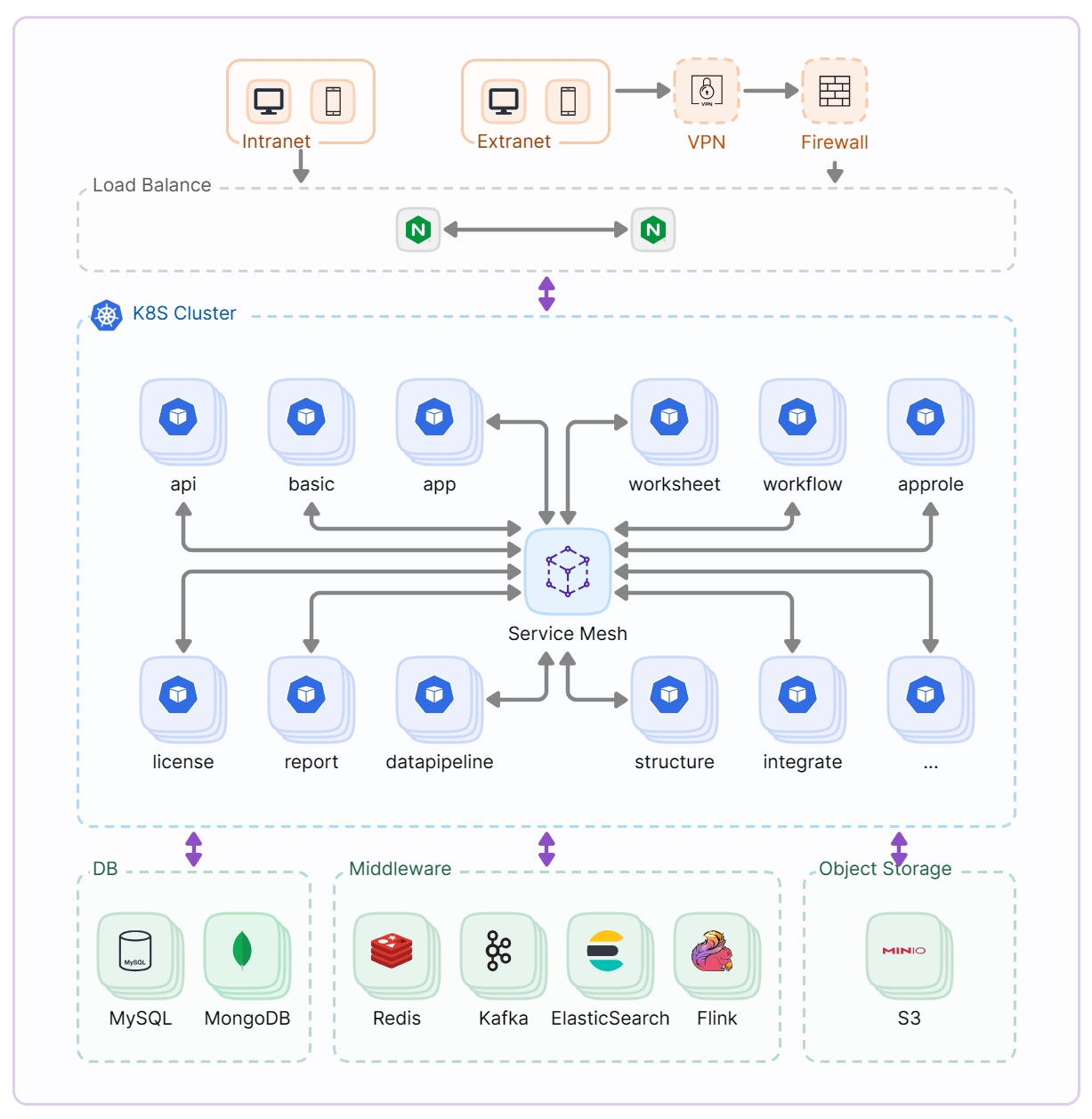Recommended Servers
Standalone Deployment Mode

Strengths: Simple and fast deployment, low server resources and O&M costs
Weaknesses: single point of failure, but it supports health checks and usually has self-recovery capabilities
Recommended server configurations are as follows:
| Concurrency | Configuration | OS |
|---|---|---|
| Within 100 | 8C/32G/40G system disk/100G data disk | Debian 10+ |
| Within 200 | 16C/32G/40G system disk/100G data disk | Debian 10+ |
| Within 300 | 24C/48G/40G system disk/100G data disk | Debian 10+ |
| 300 or more | Recommended cluster deployment mode | - |
If the file storage-related features are used more often, you also need to expand according to the actual situation, and the recommended bandwidth is 30M+.
Cluster Deployment Mode

Lite Edition (Concurrency 300+)
Strengths: save server resources and O&M costs, high availability of microservice clusters, and relatively independent deployment components, suitable for environments with limited resources or small-scale application scenarios
Weaknesses: some component coupling, possible single point of failure of storage-related services
Recommended server configurations are as follows:
| Usage | Configuration | OS | Deployed Service | Number |
|---|---|---|---|---|
| Load and Forward | 4C/8G/100G system disk/200G data disk | Debian 10+ | Nginx | 1 |
| Microservice Application | 16C/48G/100G system disk/200G data disk | Debian 10+ | HAP Microservices | 2 |
| Middleware | 8C/32G/100G system disk/500G data disk | Debian 10+ | Kafka, Elasticsearch, File Object Storage | 1 |
| Data Storage | 8C/32G/100G system disk/300G data disk (SSD) | Debian 10+ | MySQL, MongoDB, Redis | 1 |
Standard Edition (Concurrency 600+)
Strengths: Having basic high availability capabilities, such as node redundancy and higher utilization of automatic fault tolerance, and being able to effectively utilize server resources. Suitable for most usage scenarios
Weaknesses: There is interference and resource competition between different storage components, and attention should be paid to resource allocation and management
Recommended server configurations are as follows:
| Usage | Configuration | OS | Deployed Services | Number |
|---|---|---|---|---|
| Load and Forward | 4C/8G/100G system disk/200G data disk | Debian 10+ | Nginx | 2 |
| Microservice Application | 16C/48G/100G system disk/200G data disk | Debian 10+ | HAP Microservices | 3 |
| Cache | 4C/16G/100G system disk/200G data disk | Debian 10+ | Redis | 2 |
| Middleware | 8C/32G/100G system disk/500G data disk | Debian 10+ | Kafka, Elasticsearch, File Object Storage | 4 |
| Database | 8C/32G/100G system disk/300G data disk (SSD) | Debian 10+ | MySQL, MongoDB | 3 |
Professional Edition (Concurrency 1000+)
Strengths: At the same time of high availability, a single application architecture is adopted (only one component instance runs on each server) to improve reliability and performance, avoid interference and resource competition between different components, and also facilitate independent expansion and management of each component
Weaknesses: high server resources and O&M costs
Recommended server configurations are as follows:
| Usage | Configuration | OS | Deployed Service | Number |
|---|---|---|---|---|
| Load and Forward | 4C/8G/100G system disk/200G data disk | Debian 10+ | Nginx | 2 |
| Microservice Application | 32C/64G/100G system disk/300G data disk | Debian 10+ | HAP Microservices | 3 |
| Cache | 16C/32G/100G system disk/200G data disk | Debian 10+ | Redis | 2 |
| Message queue | 16C/32G/100G system disk/500G data disk | Debian 10+ | Kafka | 3 |
| Full-text search | 16C/32G/100G system disk/500G data disk | Debian 10+ | Elasticsearch | 3 |
| File Storage | 16C/32G/100G system disk/500G data disk | Debian 10+ | File Object Storage | 4 |
| RDB | 16C/32G/100G system disk/500G data disk(SSD) | Debian 10+ | MySQL | 2 |
| NoSQL | 32C/64G/100G system disk/500G data disk(SSD) | Debian 10+ | MongoDB | 3 |